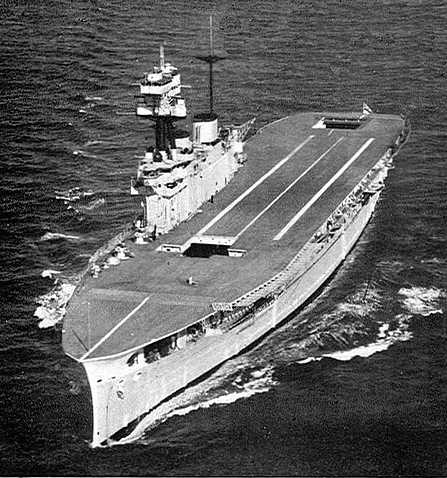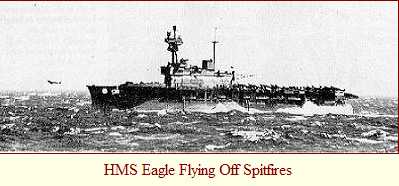A Trip to Malta
My Flight From An Aircraft Carrier
On May 11th, 1942 a random group of pilots from various squadrons in the United Kingdom set out from West Kirby, England to Gourock, Scotland where we embarked on the freighter "Empire Conrad", destination unknown. Accompanying us were 31 Spitfire Mk Vc,s in crates tucked in the bowels of the ship. From Gourock, we had a stopover at Holyhead and Milford Haven before crossing the Bay of Biscay.
As pilots, our forte was "the wild blue yonder" and the thought of a sea journey, of being torpedoed and ending up in the depths of the ocean was not comforting. However Gibralter was our next port of call and we arrived there after an uneventful trip. The aircraft were off loaded, assembled, test flown and hoisted aboard the aircraft carrier HMS Eagle.

We enjoyed a few days respite in Gibralter, good food, swimming, sunshine and sightseeing. This came to an end on June 1st when we set sail for Malta which we now knew was our ultimate destination. There were three pilots in the group who had already experienced combat above the skies of Malta and on June 2nd they conducted the briefing as to our part in "Operation Style", the code name for our mission as well as the procedure for taking off from HMS Eagle.
With the exception of the three pilots from Malta none of us had ever been on a carrier, never mind the traumatic experience of becoming airborne from one. We were given the sequence of take-off, safety precautions in the event of an abort and told that prior to take-off the carrier would be turned into wind and its speed increased to give us 30 knots over the deck. The length of the carrier being 169 yards (154m), there was some doubt that we could become airborne. The Spitfire flaps were either up or down so a method was devised so that we could acquire 23 degrees of flap with the use of wooden blocks, the optimum for maximum lift for take-off.
The briefings explained that when your turn came for take-off, you started the engine, dropped the flaps, then raised them - with the airmen inserting the wooden blocks, ran the engine up, checked the 90 gallon (410L) drop tank was feeding, back to the main tank (87 gallons/395L), again checking the revs, oil and hydraulic pressure instruments then waited for the signal to take-off. When the signal was given, full throttle, chocks away and off we went. There was no returning to the carrier as the Spitfire had no arrester hook for landing on a carrier.
On June 3rd when we were 1,000 miles (1,600K) from Malta, off the coast of Algiers the Spitfires were brought on deck from the hold by elevator among them AR377 which was mine. We were strapped in and our few personal items stowed away. The aircraft were then arranged on the deck. Now the briefing became a reality! We were as ready as we would ever be.

As we sailed along in the Mediterranean we were shadowed by JU-88s at low level on the horizon. On my take-off the JU-88s appeared overhead and as I was becoming airborne the navy escorts opened fire - I thought what a way to go - shot down by our own people or as we now call it "friendly fire". I kept going, dropping off over the bow of the carrier, gained flying speed, lowered the flaps, the wooden blocks falling away, raised the flaps and joined with the other three aircraft in our section and set off for the long flight to Malta.

On approaching Malta we were intercepted by ME-109s from Sicily and had to fight our way in, low on fuel, we kept turning in defensive circles and edging our way to the Island. One of the aircraft in our section was shot down and the rest landed. We were directed to a dispersal pen, where the ground crew immediately refueled and rearmed the aircraft. Waiting was an operational squadron pilot on stand-by, ready to be scrambled at the first sign of an incoming enemy raid. Of the 31 aircraft that took off from the carrier. only 27 arrived and one crashed on landing but the pilot was unhurt. Unfortunately, the four shot down were never recovered. It was a long tiring trip lasting three and a half hours.
Sadly on August 12th, 1942 on another of it's trips, HMS Eagle was torpedoed and sunk. The aircraft carriers had done a magnificent job in bringing Spitfires within range of Malta to reinforce the island. The "Eagle" made ten trips, the USS Wasp two trips, HNS Argus one and HMS Furious three trips. A total of 396 Spitfires were to be ferried, of which 376 reach the Island.
by W/C (Ret.) Bob Middlemiss, DFC CD
Commanding Officer 427 Squadron - December 1962-February 1964
This article originally appeared in ROAR #12, June 2002
Copyright © 2007, 427 Squadron Association
Copyright © 2007 Logistix. Designed by Free CSS Templates
::: Modified with Coffee Cup - Web Design Software:::